Laser drilling transforms your flawed diamonds by using high-powered Nd:YAG lasers to create microscopic tunnels as small as 0.02 mm that target dark inclusions within the stone. You’ll see dramatic improvements as these unsightly flaws become virtually invisible, enhancing your diamond’s clarity grade and boosting its brilliance by 30-40%. The process uses nanosecond energy pulses with advanced cooling to minimize heat damage. Understanding this enhancement technique will help you make informed decisions about treated versus natural stones.
Understanding the Science Behind Diamond Inclusions and Flaws

When you examine a diamond under magnification, you’ll discover that most contain microscopic imperfections called inclusions—tiny particles, gas bubbles, or crystal fractures that formed during the stone’s creation deep within the Earth.
These diamond inclusions directly impact your stone’s clarity grade and brilliance, with some being easily visible while others remain hidden to the naked eye. The visibility and severity of these flaws greatly affect your diamond’s aesthetic appeal and market value.
Understanding these natural imperfections is vital because they’re what the laser drilling process targets for treatment. By recognizing how inclusions form and manifest, you’ll better appreciate why advanced laser technology has become an essential tool for enhancing diamond clarity and transforming flawed stones into more desirable gems.
The Laser Drilling Process: From Identification to Enhancement
Before any laser touches your diamond, gemologists conduct a meticulous examination using high-powered microscopes to map every inclusion within the stone.
Advanced 3D mapping technology creates detailed models that guide the entire laser drilling process, ensuring superior results while preserving your diamond’s structural integrity.
The actual drilling uses Nd:YAG lasers that create microscopic tunnels as small as 0.02 mm directly to targeted inclusions.
Nd:YAG lasers create tunnels smaller than 0.02 mm, targeting inclusions with microscopic precision to enhance diamond clarity.
These precision instruments employ nanosecond energy pulses to minimize heat damage to your diamond’s crystal structure.
The laser drilling process dramatically improves clarity by providing access to treat internal flaws.
You’ll notice the drill holes appear as small, round white dots under magnification.
Industry regulations require full disclosure of this enhancement in gemological reports, ensuring transparency about your diamond’s treatment history.
Why Diamonds Undergo Laser Drilling Treatment
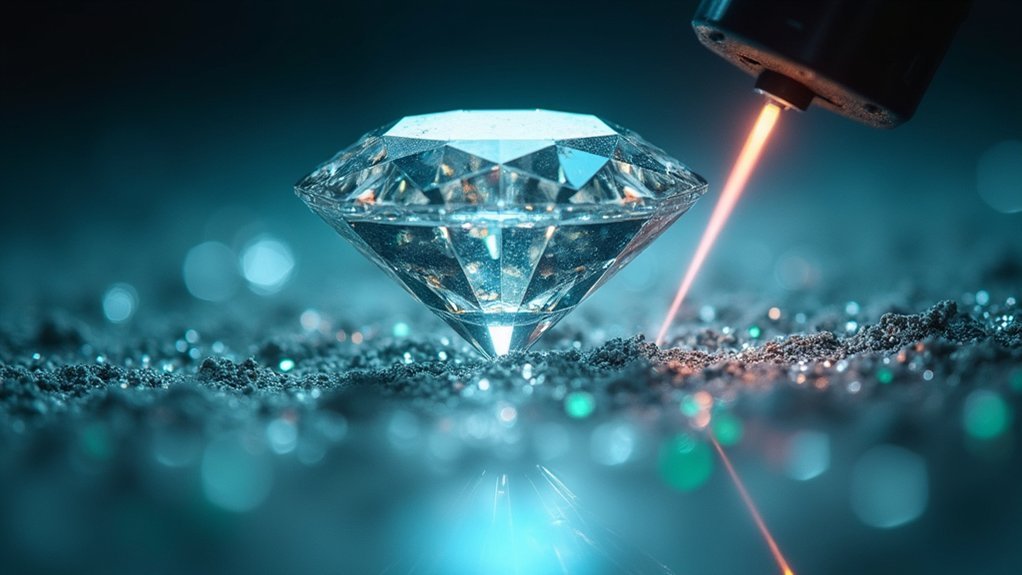
Although diamonds represent nature’s hardest material, internal inclusions can severely compromise their beauty and commercial viability.
You’ll find that laser drilling primarily targets diamonds with visible inclusions that would otherwise render them unsellable or considerably reduce their clarity grades.
This treatment transforms flawed stones into marketable gems by creating microscopic tunnels that either vaporize inclusions or make them translucent.
You’re fundamentally salvaging diamonds that jewelers would’ve discarded, converting them into valuable pieces worthy of fine jewelry settings.
The financial incentive is compelling—laser drilling can boost a diamond’s market value by 30-40% or more.
However, you should understand that treated diamonds still sell for 15-25% less than untreated stones, reflecting their slightly reduced durability and different market positioning.
How Laser Technology Creates Microscopic Pathways in Diamonds
You’ll witness cutting-edge Nd:YAG laser technology targeting diamond inclusions with pinpoint accuracy at 1064 nanometers.
The focused laser beam creates microscopic tunnels as small as 0.02 mm in diameter, carving straight pathways from internal inclusions directly to the diamond’s surface.
This precise targeting process allows gemologists to reach previously inaccessible dark spots while preserving your diamond’s structural integrity throughout the treatment.
Precise Laser Beam Targeting
When gemologists need to address internal inclusions that compromise a diamond’s beauty, they turn to Nd:YAG lasers that emit precisely focused energy at 1064 nanometers.
You’ll find this wavelength creates incredibly narrow channels, measuring just 0.02 mm in diameter, allowing technicians to target specific inclusions with surgical precision.
The targeting process requires careful analysis using high-powered microscopes and mapping technology.
You’re fundamentally creating a roadmap that determines the safest drilling path while preserving the diamond’s structural integrity.
These laser drill holes penetrate deep into the stone without causing widespread damage to surrounding crystal structures.
When executed properly, this precise targeting can improve a diamond’s clarity dramatically, transforming previously flawed stones into marketable gems with enhanced visual appeal and commercial value.
Microscopic Tunnel Formation Process
The microscopic tunnel formation begins as the Nd:YAG laser fires controlled pulses of energy directly into the diamond’s crystal matrix.
You’ll witness incredibly precise drilling that creates pathways as narrow as 0.02 mm in diameter, ensuring minimal structural damage while maximizing inclusion access.
The laser drilling process involves several critical components:
- Real-time monitoring systems that track each pulse’s impact and adjust power levels accordingly
- Advanced cooling mechanisms that prevent heat damage to the diamond’s delicate crystal structure
- Precision targeting technology that follows the predetermined drilling path mapped by gemologists
You’ll find that each tunnel serves as a microscopic highway, allowing trapped inclusions to be altered or removed.
The laser’s controlled energy vaporizes material along its path, creating clean, precise channels that transform dark inclusions into translucent features.
Visual Impact: Before and After Laser Drilling Results
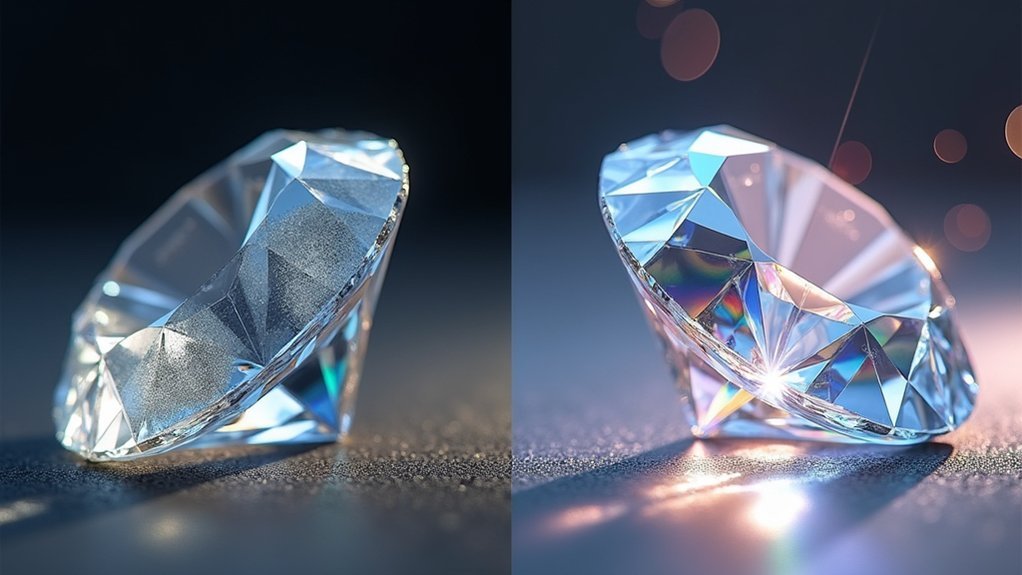
You’ll notice dramatic changes when comparing diamonds before and after laser drilling treatment.
Dark, distracting inclusions that once dominated the stone’s appearance become virtually invisible, while the diamond’s clarity grade can jump remarkably higher.
The enhanced light performance creates noticeably improved brilliance and sparkle that transforms previously unmarketable stones into visually appealing gems.
Inclusion Visibility Reduction
Before laser drilling transforms your diamond, dark inclusions can make even high-carat stones appear cloudy and unappealing, often relegating them to industrial use rather than fine jewelry.
When you choose to have your diamond laser drilled, microscopic tunnels strategically target these problematic inclusions. The process doesn’t completely remove dark inclusions, but it creates pathways that dramatically reduce their visibility.
You’ll notice the difference immediately as previously prominent flaws become virtually undetectable to the naked eye.
The transformation includes:
- Clarity enhancement – stones jump from lower clarity grades to near-clean appearances
- Brilliance restoration – light can now pass through areas previously blocked by inclusions
- Market value increase – treated diamonds typically see 30-40% value improvements
Your once-flawed diamond now sparkles with renewed brilliance and commercial appeal.
Clarity Grade Improvement
Although laser drilling creates only microscopic channels, the visual transformation in your diamond’s clarity grade can be nothing short of dramatic.
When a precise laser beam targets dark inclusions within your stone, you’ll witness a remarkable before-and-after difference. Previously unsellable diamonds with extensive visible flaws become marketable gems that appear much cleaner to the naked eye.
Your diamond’s clarity grade can jump considerably after treatment. The laser beam dissolves targeted inclusions, often elevating stones from lower clarity grades to higher ones.
This diamond’s clarity improvement translates to tangible value increases of 30-40%. What once appeared heavily included becomes a brilliant, sparkling gem with enhanced visual appeal.
The transformation allows previously flawed stones to regain their aesthetic desirability and commercial viability in today’s market.
Light Performance Changes
When light encounters your diamond’s internal structure, laser drilling creates a fundamental shift in how brilliance and sparkle emerge from the stone. The focused laser creates tiny tunnels that eliminate dark inclusions blocking light pathways, allowing dramatically improved light entry and reflection throughout your diamond.
You’ll notice these significant changes in light performance:
- Enhanced brilliance – More light enters and reflects within the stone’s facets
- Increased sparkle – Elimination of dark spots creates continuous light play
- Improved fire – Better light dispersion produces more colorful flashes
However, you must guarantee proper execution. Poor laser drilling techniques can actually diminish your diamond’s light performance, creating dull areas that reduce overall sparkle.
When done correctly, the drill holes remain virtually invisible without magnification while maximizing your stone’s visual impact.
Identifying Laser Drilled Diamonds Under Magnification
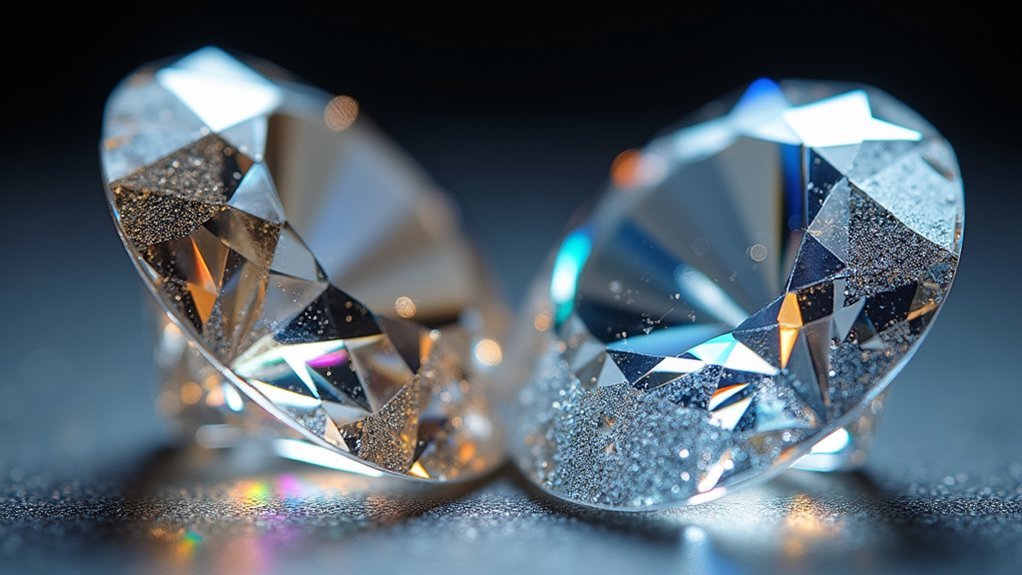
How can you tell if a diamond has undergone laser drilling treatment? Under 10x magnification, you’ll spot small, round, white dots marking the drill hole entry points on laser drilled diamonds.
These telltale signs become more obvious at higher magnification, revealing distinct circular shapes and straight paths leading from the surface to internal inclusions.
Higher magnification reveals the unmistakable evidence: perfectly circular drill entry points and laser-straight channels tunneling directly into the diamond’s inclusions.
You can also use fiber-optic illumination to highlight distinctive flash effects within the drill holes. The treated inclusions themselves will appear less prominent than natural ones, showing an altered appearance that’s characteristic of this enhancement process.
Don’t rely solely on visual inspection, though. Gemological reports are required to disclose laser drilling treatment, providing official documentation of any modifications that affect the diamond’s value and natural state.
Market Value Differences Between Treated and Natural Diamonds
The market value impact varies markedly based on several key considerations:
- Regional preferences – Asian and European consumers generally favor untreated stones, while North American markets show greater acceptance.
- Physical characteristics – Size and number of laser drill holes directly influence pricing.
- Investment potential – Treated diamonds experience more modest value increases over time.
You should also consider that laser drill holes become permanent markers affecting resale value.
The number and visibility of these holes play essential roles in determining final market pricing across different regions.
Disclosure Requirements and Industry Standards
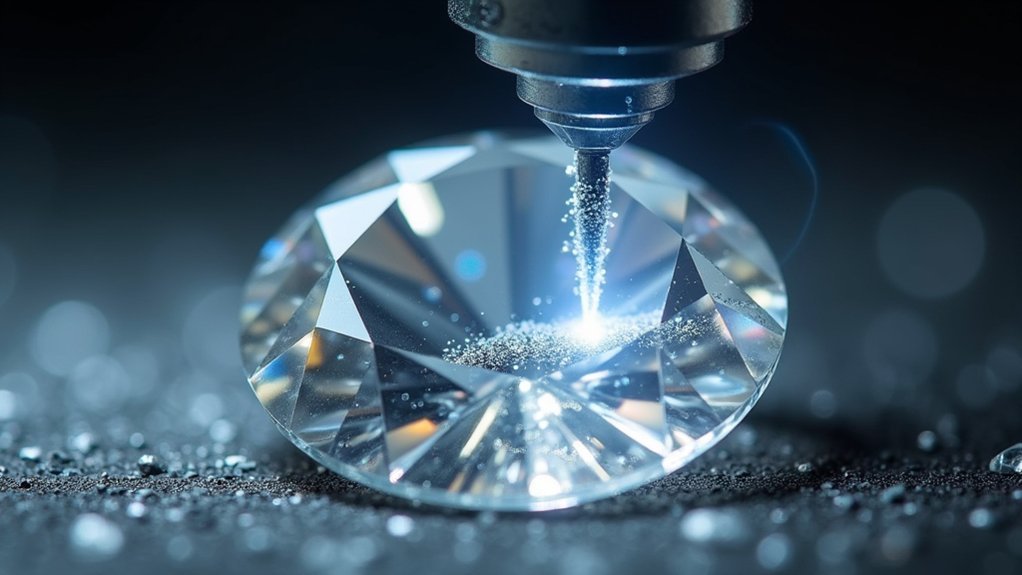
Because laser drilling permanently alters a diamond’s natural state, sellers must follow strict disclosure requirements established by industry regulatory bodies. The FTC mandates that you disclose all treatments during gemstone sales to guarantee consumer transparency.
When you purchase a diamond, reputable gemological laboratories like GIA and AGS must include laser drilling information in their reports, clearly indicating any drill holes present in certifications.
International gemological standards require that you’re informed about treatments altering diamonds’ natural characteristics to maintain ethical industry practices. These disclosure requirements greatly impact market perception and value.
If sellers fail to disclose laser drilling, they face potential legal consequences and contribute to consumer distrust. You’ll find that proper disclosure protects both buyers and sellers while maintaining marketplace integrity.
Risks and Limitations of Laser Drilling Enhancement
You’ll face several significant drawbacks when considering laser-drilled diamonds that can impact both your investment and satisfaction.
The treatment weakens the stone’s structural integrity through tiny holes that increase fracture risk, while simultaneously reducing your diamond’s resale value by 15-25% compared to untreated stones.
You must also navigate disclosure challenges, as some sellers don’t always reveal this enhancement, potentially leading you to overpay for a compromised diamond.
Structural Integrity Concerns
While laser drilling can successfully remove dark inclusions from diamonds, it inevitably creates structural vulnerabilities that you should carefully consider before enhancement. The microscopic tunnels compromise your diamond’s natural strength, creating stress points that weren’t present in the original stone.
Key structural integrity concerns include:
- Fracture risk increases – Drill holes often act as weak points where cracks can initiate under pressure or impact.
- Filler deterioration – Glass-like materials used to fill channels may break down over time, creating visible gaps.
- Permanent alteration – The drilling process irreversibly changes your diamond’s internal structure, affecting its long-term durability.
These modifications can impact both the diamond’s physical resilience and market value, with treated stones typically selling for 15-25% less than untreated equivalents.
Value Depreciation Issues
Although laser drilling can improve a diamond’s visual appearance by removing unsightly inclusions, it greatly impacts the stone’s market value and long-term investment potential.
You’ll find that laser drilled diamonds typically sell for 15-25% less than untreated stones due to perceived reduced value from treatments. The resale market presents additional challenges, as collectors and connoisseurs prefer natural, untreated diamonds, creating lower demand for treated stones.
Value depreciation becomes more severe when sellers don’t disclose treatments, potentially leading you to overpay.
Poor drilling execution can further diminish worth by affecting light performance and sparkle. The tiny drill holes also compromise structural integrity, increasing fracture risks that may worsen depreciation over time.
These factors combine to make laser drilled diamonds less attractive investments.
Disclosure and Detection
When purchasing a diamond, sellers must legally disclose laser drilling treatments according to FTC guidelines and international gemological standards.
Yet this transparency doesn’t always occur in practice. Without proper disclosure, you risk overpaying for a treated stone that’s worth considerably less than an untreated diamond.
Detecting laser drilling requires careful examination:
- Visual inspection – Look for small, round, white dots or circular entry points using magnification
- Professional certification – Seek verification from reputable labs like GIA or AGS that identify treatments
- Seller transparency – Ask direct questions about any treatments or enhancements performed
The lack of disclosure creates serious purchasing risks.
You’ll need to actively investigate whether laser drilling occurred, as these treatments aren’t always obvious to untrained eyes.
Care and Maintenance of Laser Drilled Diamonds
Since laser drilling creates microscopic tunnels within the diamond’s structure, these treated stones need specialized care to preserve their beauty and integrity.
You’ll need to clean your laser drilled diamonds more frequently than untreated stones, with professional cleaning recommended annually to maintain peak clarity.
For at-home care, use warm soapy water with a soft brush, ensuring thorough rinsing to remove residue.
Exercise caution with ultrasonic cleaners, as vibrations may worsen existing weaknesses around drill holes.
Regular inspections help detect deterioration early, particularly near treated areas.
Schedule regular professional inspections to identify potential damage or structural changes around laser-drilled areas before they become costly problems.
During repairs, avoid harsh chemicals and extreme temperatures that can compromise the treated inclusions’ durability.
This proactive approach protects your investment while preserving the diamond’s enhanced appearance.
Shopping Guide for Laser Treated Diamonds
How can you guarantee you’re making an informed purchase when shopping for laser-treated diamonds? Start by demanding certification from reputable labs like GIA or AGS that clearly identifies any treatments.
You’ll want transparency from jewelers about laser drilling, as undisclosed treatments can lead to overpaying.
When evaluating these diamonds, keep these key factors in mind:
- Price expectations – Laser-drilled diamonds typically cost 15-25% less than untreated stones
- Visibility concerns – Drill holes on top surfaces are more noticeable than side locations
- Quality priorities – Focus on cut quality first, then balance color and clarity within your budget
Remember that laser drilling affects a diamond’s clarity grade and resale value.
Always inspect the stone carefully and verify you’re paying an appropriate price that reflects its treated status.
Long-term Durability and Resale Considerations
Beyond the initial purchase decision, you’ll need to evaluate how laser drilling affects your diamond’s long-term performance and future value.
The tiny holes created during the process can weaken your diamond’s structure, increasing fracture risks and compromising durability. You’ll face significant financial impact when selling, as drilled diamonds typically command 15-25% less than non-drilled stones.
Your resale value suffers further because collectors and purists often avoid treated diamonds. If your diamond contains drill holes filled with materials that deteriorate over time, both appearance and worth decline.
Poor drilling techniques can reduce light performance, diminishing visual appeal and market desirability. Understanding these laser drilling consequences helps you make informed decisions about purchasing and maintaining treated diamonds throughout ownership.
Frequently Asked Questions
Can a Laser Damage a Diamond?
Yes, you can damage a diamond with lasers if you’re not careful. Poor execution compromises structural integrity, creates fractures, and weakens the stone. You’ll risk permanent damage since drill holes can’t be removed once created.
What Are the Disadvantages of Laser Drilling?
You’ll face reduced resale value, weakened structural integrity, and potential fractures. Fill materials can deteriorate over time, creating visible flaws. You might also experience diminished sparkle and risk overpaying for undisclosed treatments.
What Does Internal Laser Drilling Do to a Diamond?
You’ll see internal laser drilling create microscopic tunnels through your diamond, vaporizing dark inclusions to improve clarity. It’ll permanently alter your stone’s structure while making those unsightly internal flaws less visible to enhance appearance.
Are Laser-Drilled Diamonds Worth It?
You’ll find laser-drilled diamonds worthwhile if you’re seeking visual appeal at lower costs, but you’re trading durability and resale value for immediate savings and improved clarity.
In Summary
You’ll find laser drilling offers an effective solution for enhancing diamond clarity, though you should evaluate the benefits against potential drawbacks. While you can’t reverse the treatment, proper care guarantees your diamond’s longevity. You’re making a practical choice when you select laser-drilled stones, but you’ll need to contemplate resale implications. Remember, disclosure’s essential when purchasing, so you’ll know exactly what you’re buying and can make informed decisions.

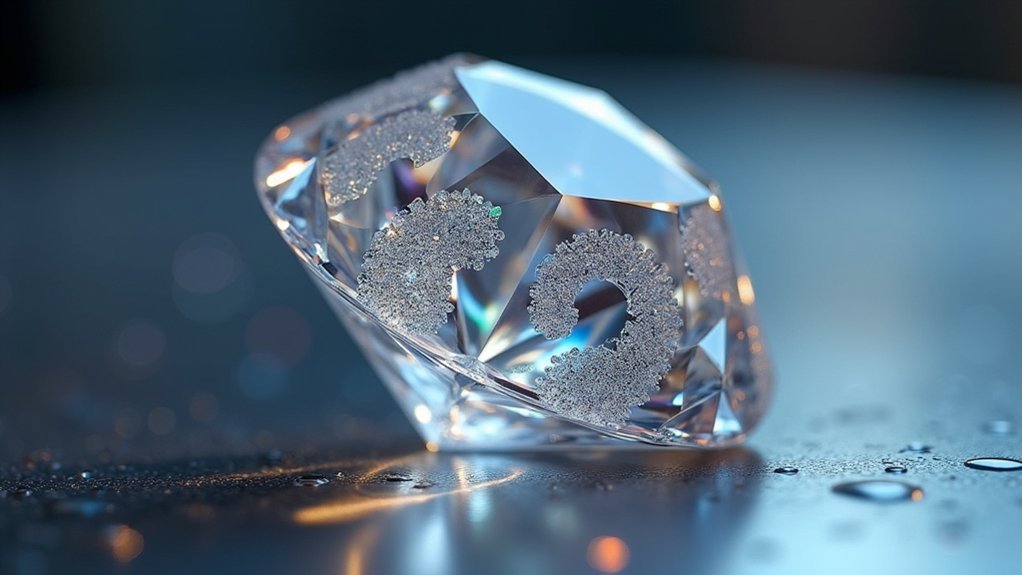


Leave a Reply